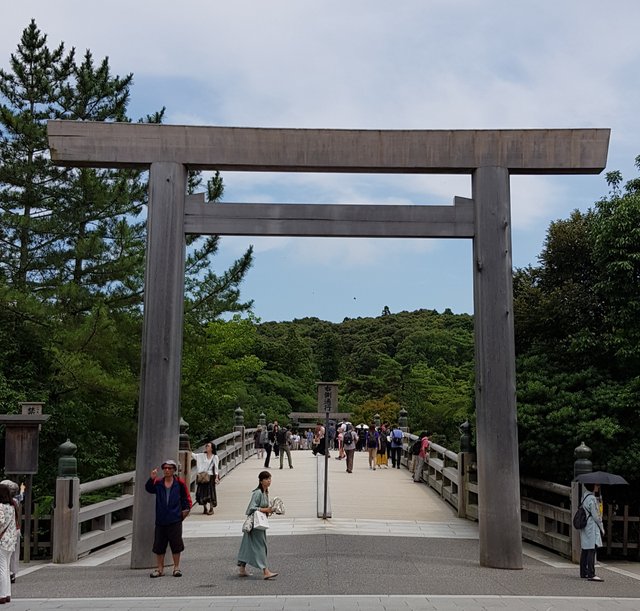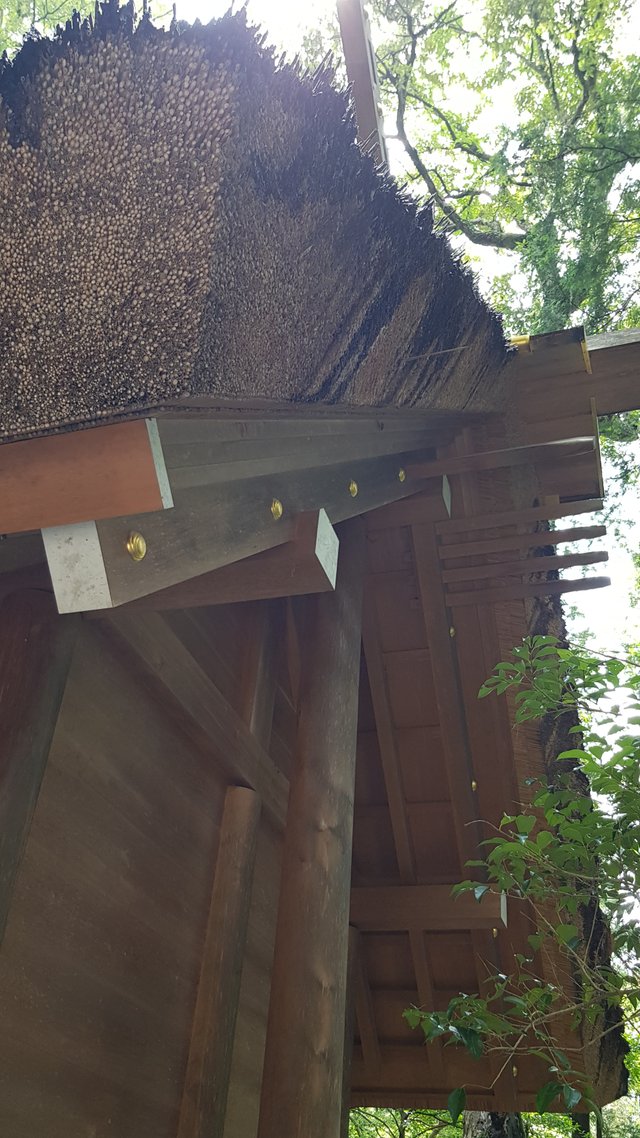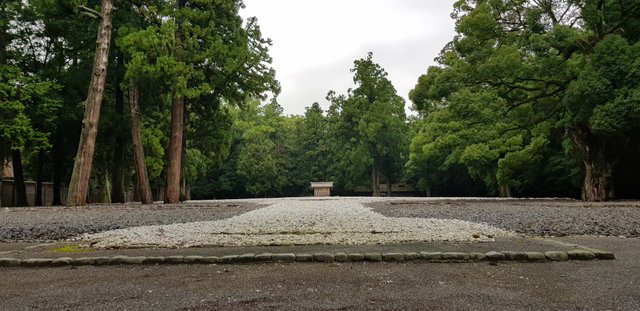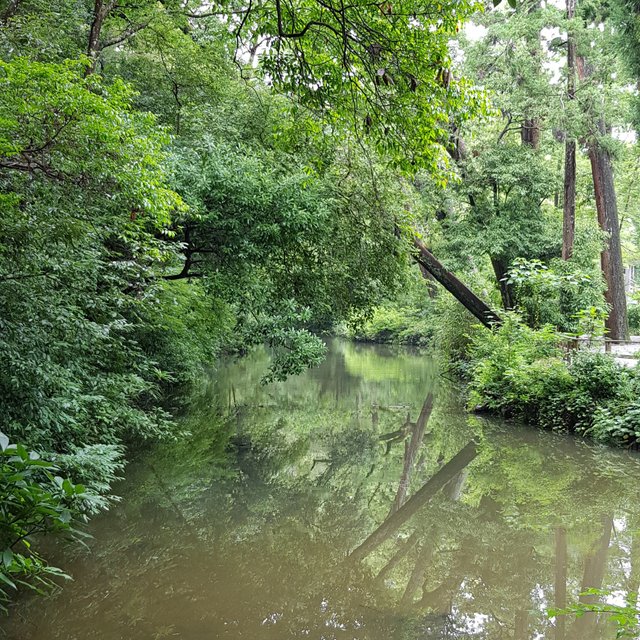Summer Vacation in Japan #2: Ise Grand Shrine
After a first day with terrible weather, I luckily woke up to not exactly clear skies, but weather decent enough to venture out to what I originally came to Toba for: The Ise Grand Shrine!

Gate at the entrance to the Inner Shine
The Ise Grand Shine is the hidden gem of any tourist even marginally interested in Japanese history. While plenty of Japanese tourists venture out to see the shine, its relatively remote location in the easternmost corner of Mie prefecture far away from the major shinkansen lines means that it is not overrun by foreign tourists to the extent that for example the old capital Kyoto is, and the ancient shrine complex has a very long and fascinating history.
According to legend, the shine was founded around 2000 years ago by princess Yamatohime-no-mikoto, daughter of the 11th emperor of Japan, Emperor Suinin after twenty years of searching as a permanent site to worship Amaterasu, the Shinto goddess of the sun and patron goddess of the Japanese Imperial house. The shrine complex consists of the Naiku or Inner Shrine, dedicated to Amaterasu and Geku or Outer Shrine dedicated to the Shinto god of agriculture and industry Toyouke-Omikami. What struck me about both this Shrine complex along with other Imperial shrine complexes like it, is how different they are from religious sites of the Abrahamic religions that I have seen in Europe. Where the principal holy sites of both Christianity and Islam are imposing, extravagant stone structures erected on huge plazas in the middle of large cities, the Ise Grand Shrine consists of simple wooden structures with thatched roofs built on a densely wooded mountain some ways away from the city betraying the animistic origins of the religion as well as the underlying nature of Shinto worship.

Auxiliary Shrine Building at the Inner Shrine
The design of the shrine structures is extremely simple utilizing an ancient design resembling early rice granaries dating back to the Kofun Period (250-538 C.E.). All structures are made of Japanese cypress wood of the highest quality and built without any metal nails using only joined wood. While being both the principal shrine of Shinto as well as the purported home to the Sacred Mirror, one of the quasi-legendary regalia of the Japanese Emperor, the most interesting feature of the Ise Grand Shrine is the fact that it is completely rebuilt every 20 years as a part of the Shinto belief of the death and renewal of nature and the impermanence of all things in a process known as sengu. The shrine buildings at both Naiku and Geku has empty plots of land located next to them known as Kodenchi, which are strewn with white pebbles and are empty aside from a small wooden hut in the middle. These plots of land are where the new shine buildings are to be erected once the reconstruction process begins. The small huts in the middle house sacred wooden poles, that are never seen as the new shrine is built around the tiny wooden hut before it is torn down and vice versa. The shrine was last rebuilt in 2013 and are currently on their 62nd iteration.

Kodenchi at the Outer Shrine
As with many other things in Shinto, the Ise Grand Shrine is shrouded in mystery. The main shrine buildings are barred for visitors to enter and even the information signs, which in the rest of Japan does its best to accommodate us stupid foreigners, who cannot read kanji, seem almost purposely obscure. You could say it is one of the things that makes Shinto so mysterious and fascinating: The numerous inaccessible inner sanctums, the central poles of the kodenchi you never get to see and the regalia of the Emperor, which are never seen, not even during the new emperor's inauguration, etc. etc.

The lush wooden areas surrounding the shrine complex help to instill a sense of serenity
The visit to the Ise Grand Shrine was an amazing experience. It is a place that due to its unique history feels both new and ancient at the same time and its beautiful sylvan surroundings really helps to add to the feeling of mysteriousness and holiness.
Thank you for reading! If you like this post, please leave an upvote and a comment and do not forget to follow me for more updates from my ongoing trip to Japan! You can also read the first entry in the series here also
As always Japan is beaiyiful
Posted using Partiko Android
Japan is amazing for sure :)
Congratulations, your post was discovered and featured by @OCD in its daily compilation #374!
If you give @ocd a follow – you can find other Gems!
With this nomination you will be able to use @ocdb - a non-profit distribution bot for whitelisted Steemians. We usually add everyone nominated at the end of the week. :) Check our website for the whitelist, queue and delegation info. Join our Discord channel for more information.
We also have a witness. You can vote for @ocd-witness with SteemConnect or on Steemit Witnesses to help support other undervalued authors!
Hello!
This post has been manually curated, resteemed
and gifted with some virtually delicious cake
from the @helpiecake curation team!
Much love to you from all of us at @helpie!
Keep up the great work!
Manually curated by @steemflow.
Thank you @helpiecake and @steemflow :D
I love places like these, they are not so overcrowded by people and still retain that serenity that shrines are supposed to exude... Having said that, I used to hate the long travels visiting these places when I was younger. They were kinda uncool for teenage kids to care for, lol...
Gorgeous photos and write-up, Cogi <3 Love these entries ! Keep 'em coming <3
Thank you, @veryspider - I sure will! ^_^
Congratulations @cogitecture! You have completed the following achievement on the Steem blockchain and have been rewarded with new badge(s) :
You can view your badges on your Steem Board and compare to others on the Steem Ranking
If you no longer want to receive notifications, reply to this comment with the word
STOPVote for @Steemitboard as a witness to get one more award and increased upvotes!